Why do some picture books stay in print for decades? by Paeony Lewis
 Some picture books go out of print in a year, whilst others stay in print for twenty, thirty or fifty years. Is it because these perennial favourites are outstanding? Or is it because some books quickly become dated? For example, times change, and I couldn’t resist including an original illustration (by Peggy Fortnum) from the young chapter book Paddington at Large (1962). It shows Paddington smoking a cigar. He wasn't being a naughty, unhealthy Paddington in the 1960s!
Some picture books go out of print in a year, whilst others stay in print for twenty, thirty or fifty years. Is it because these perennial favourites are outstanding? Or is it because some books quickly become dated? For example, times change, and I couldn’t resist including an original illustration (by Peggy Fortnum) from the young chapter book Paddington at Large (1962). It shows Paddington smoking a cigar. He wasn't being a naughty, unhealthy Paddington in the 1960s!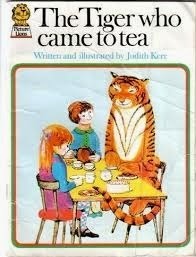 My musings about the longevity of picture books began when a friend asked me why books like Judith Kerr's The Tiger Who Came To Tea stay in print (first published 1968). My friend wondered what it was that keeps some books in print. My initial answer was to say that if a child enjoyed a book when they were young, then they’d remember and buy it to share with their children. But now I'm not so sure.
My musings about the longevity of picture books began when a friend asked me why books like Judith Kerr's The Tiger Who Came To Tea stay in print (first published 1968). My friend wondered what it was that keeps some books in print. My initial answer was to say that if a child enjoyed a book when they were young, then they’d remember and buy it to share with their children. But now I'm not so sure.I suspect grandparents may play a more important role in keeping picture books in print. As parents, we remember which books we enjoyed sharing with our children (these may, or may not, also be the children’s favourites). Then when the parents become grandparents, if they see the book in a shop they become nostalgic and buy the book for their grandchildren.
 By Paeony Lewis, illus by Penny IvesWhat evidence do I have to back this up? Not a lot! However, my I’ll Always Love You is now a scary 14 years old and although it's not in the same category as the classics, I've begun getting lovely emails from new grandparents telling me they’re buying the book for their grandchild because they remember reading this story of unconditional love to their child. These grandparents tend to be American as it's especially popular there and a new bookshop edition has just come out.
By Paeony Lewis, illus by Penny IvesWhat evidence do I have to back this up? Not a lot! However, my I’ll Always Love You is now a scary 14 years old and although it's not in the same category as the classics, I've begun getting lovely emails from new grandparents telling me they’re buying the book for their grandchild because they remember reading this story of unconditional love to their child. These grandparents tend to be American as it's especially popular there and a new bookshop edition has just come out.Thank you grandparents, but why have I discounted my theory about parents buying picture books that they enjoyed when they were children? I'm sure there are exceptions, but my gut says there are two reasons why it's not necessarily new parents (OK, my gut isn't scientific, so feel free to disagree!).
Firstly, do all adults remember and reminisce about the picture books they enjoyed as children? I do, but I work in the world of picture books and still have my old books, so I'm not necessarily typical. I asked my ‘children’ (21 and 19) which picture books they remembered liking, and they struggled. YES, THEY STRUGGLED! I feel miffed!
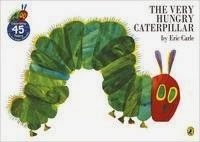 First published 1969One forgetful child admitted there were so many picture books it was hard to remember (interesting, when I was a child I had just a few that were looked at continuously). The glorious The Very Hungry Caterpillar was the only one remembered by my son, but he claimed no strong emotional attachment to it.
First published 1969One forgetful child admitted there were so many picture books it was hard to remember (interesting, when I was a child I had just a few that were looked at continuously). The glorious The Very Hungry Caterpillar was the only one remembered by my son, but he claimed no strong emotional attachment to it.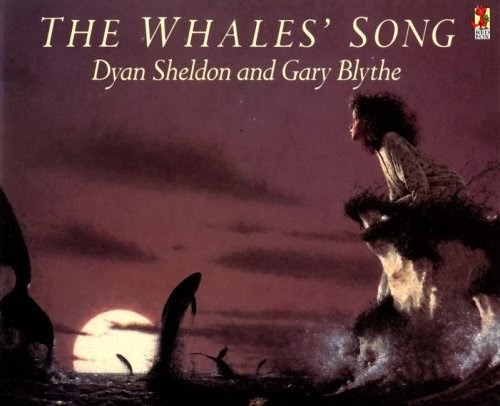 First published 1990My daughter particularly remembered one evocative book about a whale and after a discussion she agreed it was The Whale’s Song. I knew she adored that one because I read it to her over and over and over again. I also mentioned others I knew she had adored, but she had no memory of these once-favourite books. Perhaps if I’d dug them out she’d have recognised them, although she denies remembering Demon Teddy, despite being shown the damming evidence that once upon a time she liked him (see image!).
First published 1990My daughter particularly remembered one evocative book about a whale and after a discussion she agreed it was The Whale’s Song. I knew she adored that one because I read it to her over and over and over again. I also mentioned others I knew she had adored, but she had no memory of these once-favourite books. Perhaps if I’d dug them out she’d have recognised them, although she denies remembering Demon Teddy, despite being shown the damming evidence that once upon a time she liked him (see image!). Somebody liked Nicolas Allan's Demon Teddy!
Somebody liked Nicolas Allan's Demon Teddy!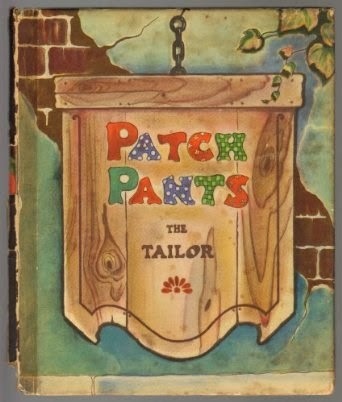 By George ChristianIf I have grandchildren (no pressure, my dearest children…) I know I’ll be buying them new picture books as well as books that fill me with nostalgia for the days when they were tiny and we curled up together to share books. However, I never shared or bought my children the picture books I adored as a child. Why’s that? I've decided it’s because they’re too personal, aren't necessarily great, and they are a product of their time and most aren't in print. Even so, I’ll share three with you (and perhaps more another time).
By George ChristianIf I have grandchildren (no pressure, my dearest children…) I know I’ll be buying them new picture books as well as books that fill me with nostalgia for the days when they were tiny and we curled up together to share books. However, I never shared or bought my children the picture books I adored as a child. Why’s that? I've decided it’s because they’re too personal, aren't necessarily great, and they are a product of their time and most aren't in print. Even so, I’ll share three with you (and perhaps more another time). Patch Pants the TailorI'm sure nobody has heard of Patch Pants the Tailor. A strange book and inappropriate (we were embarrassingly ignorant in the 1960s and it was first published in 1947). However, I adored this book and I think it was because Patch was unhappy and wanted more from life than patching and mending clothes, so he sailed in a boat with Salty the sailor and they were wrecked on a clichéd tropical island complete with 'natives' they suspected were cannibals (I told you it was embarrassing). Anyway, Patch sets up shop on the island and lives happily ever after. And why did I like it? My inner pop psychologist says it was because I was unhappy at home and wanted to escape (probably true as I did make up detailed plans for running away!).
Patch Pants the TailorI'm sure nobody has heard of Patch Pants the Tailor. A strange book and inappropriate (we were embarrassingly ignorant in the 1960s and it was first published in 1947). However, I adored this book and I think it was because Patch was unhappy and wanted more from life than patching and mending clothes, so he sailed in a boat with Salty the sailor and they were wrecked on a clichéd tropical island complete with 'natives' they suspected were cannibals (I told you it was embarrassing). Anyway, Patch sets up shop on the island and lives happily ever after. And why did I like it? My inner pop psychologist says it was because I was unhappy at home and wanted to escape (probably true as I did make up detailed plans for running away!).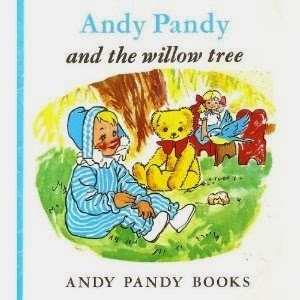 There's one small picture book that I did buy again (only for me), and that's because the original was lost on a trip to a garden centre. A relative wasn't sure he'd recognise a weeping willow tree, so I lent him my ancient copy of Andy Pandy and the Willow Tree. I'd always loved the images of the 'toys' having a picnic deep inside the green tent of dappled leaves. It seemed magical and I even included a picnic under a willow tree in a story that was almost published. One day...
There's one small picture book that I did buy again (only for me), and that's because the original was lost on a trip to a garden centre. A relative wasn't sure he'd recognise a weeping willow tree, so I lent him my ancient copy of Andy Pandy and the Willow Tree. I'd always loved the images of the 'toys' having a picnic deep inside the green tent of dappled leaves. It seemed magical and I even included a picnic under a willow tree in a story that was almost published. One day...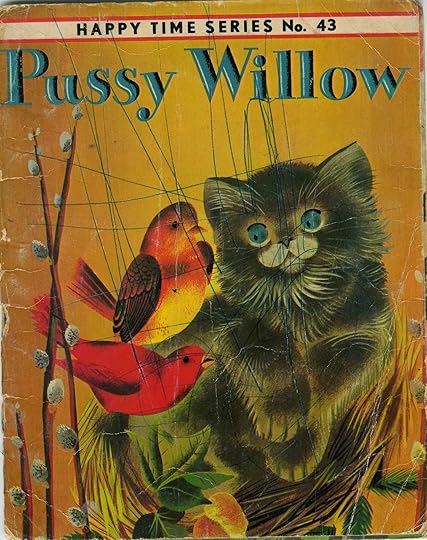 My 'annotated' 1963 edition.
My 'annotated' 1963 edition. By Margaret Wise Brown,
Illus by Leonard Weisgard Another book that made a visual impression was Pussy Willow. I remember enjoying the illustrations and the flowery language of Margaret Wise Brown, and I still have a soft spot for pussy willow in the spring (and cats).
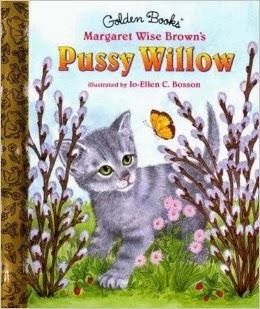 New 1997 illustrations - not for me.It was originally published in 1951 and my edition is 1963. I've discovered a 1997 edition with new sugary illustrations. Why did they do this? If something is an old favourite, why change the illustrations? Nobody would re-illustrate The Gruffalo, Where the Wild Things Are, Owl Babies, Peepo or Madeline (oops, I've just checked and there are new illustrations for a Madeline series, sigh).
New 1997 illustrations - not for me.It was originally published in 1951 and my edition is 1963. I've discovered a 1997 edition with new sugary illustrations. Why did they do this? If something is an old favourite, why change the illustrations? Nobody would re-illustrate The Gruffalo, Where the Wild Things Are, Owl Babies, Peepo or Madeline (oops, I've just checked and there are new illustrations for a Madeline series, sigh).It's about time I returned to the original topic. Why do some picture books keep on going? Are grandparents key to a book staying in print for several decades? I think so, although a book has to be popular to begin with, and stay in print (that's vital, and media tie-ins help with this). Plus I feel it needs to be the sort of book that is either utterly brilliant or has an emotional pull that evokes loving memories. So what makes a classic book that stays in print? Tricky! There are lots of wonderful books that haven't lasted decades. Any suggestions for resurrections?
Paeony Lewis
www.paeonylewis.com
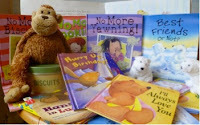
Published on February 04, 2014 00:00
No comments have been added yet.



